The MGA With An Attitude
BRAKE LIGHT SWITCHES, Good Ones - ET-119G
458 - Lucas England
On o3 October 2015, R J Goebel in Queensland Australia wrote:
"Removed the old switch today. It is marked "Lucas England" and a number of "458". with spade terminals. My 1600 is a late 1960 Australian build, so don't know if it is original fitment or a replacement. I have owned the car for 14 years (so at least that old). .... As the failure was the switch remaining on rather than the usual recent failure types, my plan is to cut the switch open, and post a picture".
On 03 October 2015, R J Goebel in Queensland Australia wrote:
"Opened up the old Lucas switch, different design than the one on Barney's site. A rubber washer deforms under pressure and presses on a thick copper disc which in turn presses down onto a set (two piece) blade contacts. The top blade makes a circuit and when the pressure is released the smaller blade springs the top blade thus breaking contact. The terminal holding the blade(s) looks like solid copper, the other terminal is silver colored, silver perhaps. The underside of the contact blade is also silver in appearance.
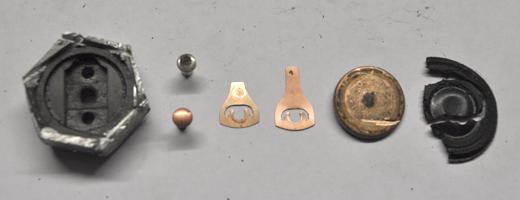
"There is some discoloration of the contacts, however this had not stopped the brake light from operating ... quite the opposite it would not turn off. Looks like a well made part, and had been on the car for more than 14 years".
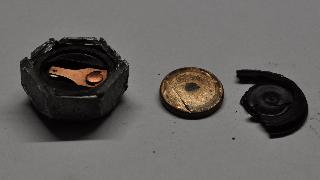

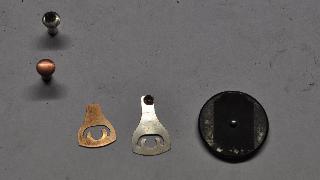
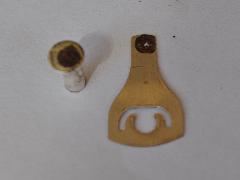
On 10/4/2015, Russell Goebel wrote:
"Part number 34542B and date code 8/65. So has been in the car (as a replacement) sometime between 1965 and 2000 when I purchased the car.
 "The silver color on the contact and underside of the contact point, looks like plating of some type. The silver terminal is copper (colored) inside. The other terminal to which the points are attached looks like copper...although it could be brass. The rubber washer seems to be similar material to that used in the S.U Fuel pump diaphragm. The metal washer has a small point (a couple of thou in height) on the underside this ultimately pushes on the center of the contact. The external terminals are brass and spade (Lucas) type. "The silver color on the contact and underside of the contact point, looks like plating of some type. The silver terminal is copper (colored) inside. The other terminal to which the points are attached looks like copper...although it could be brass. The rubber washer seems to be similar material to that used in the S.U Fuel pump diaphragm. The metal washer has a small point (a couple of thou in height) on the underside this ultimately pushes on the center of the contact. The external terminals are brass and spade (Lucas) type.
 "After looking at the parts today, looks like the failure was due to burning of the contacts. You can see a small hole in the contact blade. The failure was the brake light remaining on...the points must have welded together. Suppose this is a better failure, rather than the brake lights not working at all". "After looking at the parts today, looks like the failure was due to burning of the contacts. You can see a small hole in the contact blade. The failure was the brake light remaining on...the points must have welded together. Suppose this is a better failure, rather than the brake lights not working at all".
Now we are getting somewhere. This is the first switch I have seen (disassembled) that has the proper electrical contacts. Gotta love it. They should all be made this way. The rivets securing the contacts are different materials. The copper rivet holds the two spring arms in place. The shorter arm is underneath and serves as a leaf spring to push the longer arm away from the contact point. The longer arm appears to be silver plated. When actuated, the rubber diaphragm deflects moving the metal disc which pushes the longer arm into contact with the silver plated rivet. Not only is it good contact materials, but it could be made to be a snap action contact (although I don't think this one is). This design will be a very long lasting switch. Long Live Lucas!
Addendum June 19, 2021:
On 6/18/2021, Barry Measom wrote:
"I have just had one of those rare brake switch failures with the contacts failing to open and keeping brake lights permanently on. No residual brake line pressure and no wiring issues. When removed switch had a reading of 5 ohms across terminals. I don't feel I can complain too much as the switch is original Lucas HL2, date of manufacture 10/56 same as car and I've run with it for the last 8 years with no problems"!
On 6/19/2021, Barry Measom wrote:
"Photos as requested. The markings you can just make out 10 56, which ties in with carís date of manufacture. The part no appears to be 31082E though this again is very
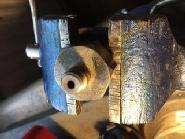 hard to read. Iím reluctant to break it open, as when I was testing it I gave it a sharp tap on the bench and it immediately went open! So it looks like it was just stuck. It seems to test fine now. I wonít be putting it back in service but it will be going in my box of ďget you homeĒ spares for when the new one fails. The 1950ís Lucas parts were generally of good quality, it was just later they went cheap. Also the old switch is significantly larger (1in AF) than modern replacements.
hard to read. Iím reluctant to break it open, as when I was testing it I gave it a sharp tap on the bench and it immediately went open! So it looks like it was just stuck. It seems to test fine now. I wonít be putting it back in service but it will be going in my box of ďget you homeĒ spares for when the new one fails. The 1950ís Lucas parts were generally of good quality, it was just later they went cheap. Also the old switch is significantly larger (1in AF) than modern replacements.

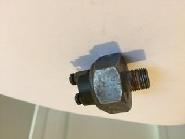

|